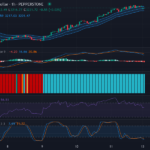Ray Dalio’s Warning: U.S. Faces Imminent Recession Amid Trade War Turbulence
Tháng 4 13, 2025
Gold vs. US Dollar: An In-depth Technical Analysis – 14/04/2025
Tháng 4 13, 2025Recent Economic Indicators in New Zealand: A Comprehensive Analysis
As of March 2025, New Zealand’s economic indicators have shown notable shifts, particularly within the manufacturing and services sectors. This blog post aims to provide an in-depth analysis of key economic metrics, showcasing not only current performance but also potential implications for the nation’s economic landscape.
Manufacturing Performance: PMI Insights
The BusinessNZ Performance of Manufacturing Index (PMI) recorded a value of 53.2 in March, a slight decrease from February’s 53.9. Despite this decline, the index continues to indicate expansion for the third consecutive month, reflecting resilient manufacturing activity. Within this framework, production stood out with a robust reading of 54.2, marking its highest level since December 2021. Employment figures also mirrored the positive trend, reaching 54.7, the most significant measure since July 2021.
However, it is crucial to note that not all metrics paint a rosy picture. The new orders sub-index dropped to 49.6, suggesting a return to contraction in this area. This decline raises concerns about the sustainability of the recent recovery, as weak demand and fewer new orders could hinder future growth. Adding to the uncertainty, the volatility in global trade policies may further impact the manufacturing sector’s performance in the coming months.
Services Sector: State of the Performance Index
While the manufacturing sector is grappling with its challenges, the services realm presents a mixed narrative. As of February 2025, the BNZ-BusinessNZ Performance of Services Index (PSI) was reported at 49.1, indicating a contraction in services activity. The sub-indices reveal a concerning trend where Activity/Sales were recorded at 49.2, New Orders/Business at 49.4, and Employment at 48.9. Notably, this performance follows a brief period of expansion observed in January 2025, reflecting a retraction that raises questions regarding the sector’s immediate recovery prospects.
Broader Economic Indicators and Outlook
Shifting focus to general economic conditions, New Zealand’s unemployment rate has escalated to 5.1% in the December quarter – the highest since December 2016, excluding the COVID-19 pandemic’s impact. This increase in unemployment highlights a pressing issue as it coincides with declining consumer confidence, which can severely influence overall economic health and spending behaviors.
In response to these changing economic dynamics, experts anticipate further cuts to the cash rate as a means to stimulate growth amidst a challenging global backdrop. The central bank’s strategy aims to encourage borrowing and investment, yet the effectiveness of such measures remains to be seen in the context of fluctuating global conditions. For more insights into investment and economic strategies, check out 3 Reasons Greenblatt Says Value Investing Beats Market.
Conclusion: Navigating Uncertainty in Economic Growth
In summary, New Zealand’s current economic indicators present a complex tableau of growth and challenges. While the manufacturing sector demonstrates resilience with positive production and employment figures, the decline in new orders and the contraction in services signal caution ahead. With an increasing unemployment rate and declining consumer confidence, stakeholders are urged to prepare for a potentially volatile economic period. For those navigating this environment, it’s essential to recognize and Top Investment Mistakes to Avoid in 2023 as a reference point. Policymakers must remain vigilant and proactive in their strategies to ensure sustainable growth and stability in the months to come. The path forward will depend heavily on addressing both domestic and global economic uncertainties effectively.
